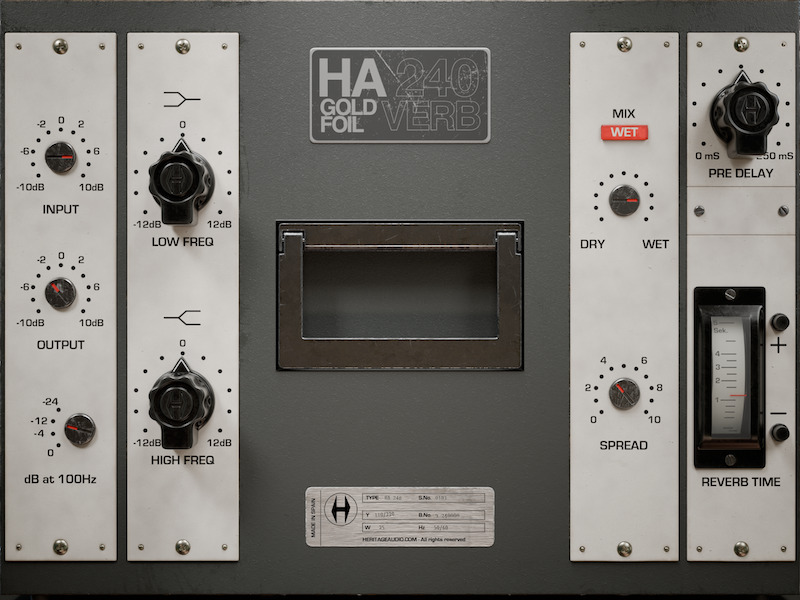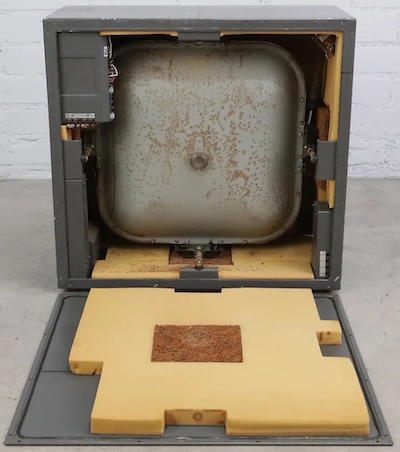
| Back To The Directory |
Heritage Audio HA 240 Gold Foil Reverb Plug-in
By Barry Rudolph
 |
| Heritage Audio HA 240 Gold Foil Reverb Plug-in |
Heritage Audio has an excellent emulation of the original EMT 240 Gold Foil Reverb now in a plug-in. The EMT 240 was physically smaller than the previous EMT 140 plate. The EMT 240 came in a 64 X 63 X 30 cm box cabinet with controls, carrying handles and weighed 67kg (148lbs).
By contrast, the EMT 140 measures approximately 122H X 244L cm and has a 2 meter by 1 meter metal plate inside. It weighs 270kg (nearly 600 pounds). In addition, the 140 requires a quiet, sound proof room for operation.
The EMT 240 was designed to be located right in the control room--even near the console. My first experience in the studio was when the producer had a 240 brought into the control room for me to use on a mix for him. On the outside, the EMT 240 looks pretty ordinary--a box with a few controls, stereo audio in/out XLRs, and sockets for the mains and a multi-pin jack for the hardware remote control.
The EMT 240 Reverb Foil uses an electroplated 24k gold foil sheet measuring 270 x 290 mm (10.62 X 11.41 inches) and only 18 microns or .00071-inches thick. The foil is mounted under tension in a frame with a driver. The sheet's vibrations are picked-up by transducers much like the EMT 140 plate. This entire assembly is incased in a metal "tank" that is shock-mounted and contained within a larger box.
 |
| Inside A Vintage EMT 240 Gold Foil Reverb |
HA 240 Gold Foil
Heritage Audio carried over the look of the original unit with its GUI controls including +/- reverb time buttons plus an meter indicator you can mouse over and change. Modern Pre-delay and Wet/Dry controls were added and there is a Spread control to adjust the stereo width from mono out to full stereo. There are stereo Input and Output controls and the low and high pass filters were based on the original units.
In the Studio
Coming up with an unique reverb is important for main instruments and vocals in a mix. I want the richness and spacious width without flooding all the air and transparency out of the mix. That is easy to get with the HA 240 Gold Foil.
Vocals
I installed the latest 1.0.6.1 version and started designing an effect I've been thinking about. After panning two background vocal tracks mid left and right, I set up two mono instances of the HA 240 mono Reverbs with their output returns panned hard right and left. The two vocal tracks had stereo aux send faders switched to pre. The tracks themselves were solo'd and muted. In this way I could hear just the 240's returns oppositely panned right and left. The gold foil was set to 1.5 seconds on Reverb Time meter. Here, I'm using reverb as a "color" to add a bright plate sound. These short reverb time settings are what I remember about the EMT 240.
 |
| Vintage EMT 240 Gold Foil Reverb |
Main Stereo Reverb
I went back to a regular stereo reverb with a reverb time set to 2 seconds. Longer reverb times tend to sound a little dark during the decay time but I liked that sound mixed into a thick synth pad. The High Frequency shelf was at +4dB or 3 dots to the right, Low Frequency shelf was at 0dB, Spread was at 10 or full stereo, pre-delay is at about 30ms or 3 dots-- (the controls are not marked or graduated in dB) and the 100Hz High Pass filter was at -12dB. The 100Hz high-pass filter has choices of 0db or flat, -4, -12, and -24dB. It's a good idea to use at least -4dB HPF to keep low frequencies from getting in the reverb.
This setup worked nicely for a snare drum reverb although I eventually backed down the high frequency shelf EQ down to fit the track better. For a handclap track, I used a reverb time of 0.5 without Pre-Delay and all other controls at flat. Just for fun, I automated the Spread control so the reverb is mono in the verses and full stereo in the choruses. During a busy, full mix, this is a subtle mix move but I liked it!
This is good reverb for vocals, percussion elements, or sustaining pads as a tone changer. Recommended!
Company: Heritage Audio
Product: HA 240 Gold Foil Reverb Plug-in
Price: $99 MSRP
Pros: Great sounding reverb based on a classic
Cons: Good for colorful, shorter reverbs.
|
|
|